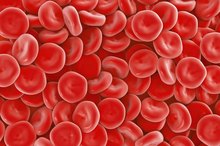Gamma Radiation Effects
Gamma radiation is a form of nuclear radiation produced by certain radioactive elements as they decay. In particular, gamma radiation is ionizing radiation, meaning that it is sufficiently energetic to break bonds in genetic material, structural components of cells and other biological molecules. For this reason, exposure to gamma radiation can cause a number of health effects, some of which accumulate over time, and others of which are acute 2. While the body has the ability to repair damage, its ability to repair radiation-related damage can be overwhelmed at high doses or if radiation accumulates over many years.
If you are experiencing serious medical symptoms, seek emergency treatment immediately.
Mild Radiation Sickness
If an individual is exposed to small doses of gamma radiation, or very small doses of gamma radiation regularly for some time, they may develop a mild case of radiation poisoning. While radiation can kill any body cell, the most susceptible cells are the fastest-growing ones, since their genetic material is most exposed. As a result, the skin, hair and gastrointestinal tract cells are most likely to be affected first in radiation exposures. According to the Mayo Clinic, symptoms of mild radiation poisoning include nausea and vomiting, progressing to generalized weakness and fatigue several weeks later 1.
- If an individual is exposed to small doses of gamma radiation, or very small doses of gamma radiation regularly for some time, they may develop a mild case of radiation poisoning.
- As a result, the skin, hair and gastrointestinal tract cells are most likely to be affected first in radiation exposures.
Severe Radiation Sickness
Radiation Effects on the Environment
Learn More
Larger acute doses of gamma radiation, or larger doses that accumulate over time, can lead to much more severe symptoms. These may include diarrhea, headache, hair loss, skin burns and poor healing, according to the Mayo Clinic 1.cause:
- These may include diarrhea
- headache
- hair loss
- skin burns
- poor healing
- according to the Mayo Clinic 1
A 2007 study published in “Health Physiology” also reports that severe radiation sickness can result in death, either immediately or within months 1. The study notes that delayed radiation deaths were generally attributable to bone marrow failure. Since the bone marrow, like skin, contains rapidly dividing cells, it’s quite vulnerable to radiation. The marrow is responsible for producing both red and white blood cells—the red cells carry oxygen to the tissues, and the white cells are part of the immune system. Failure of the bone marrow to proliferate blood cells properly is fatal.
- Larger acute doses of gamma radiation, or larger doses that accumulate over time, can lead to much more severe symptoms.
- The marrow is responsible for producing both red and white blood cells—the red cells carry oxygen to the tissues, and the white cells are part of the immune system.
Cancers
Individuals who are exposed to gamma radiation, even if they recover from the acute and chronic effects of radiation sickness, are at increased risk for cancer, notes the Environmental Protection Agency, or EPA 13.cause:
- Individuals who are exposed to gamma radiation
- even if they recover from the acute
- chronic effects of radiation sickness
- are at increased risk for cancer
- notes the Environmental Protection Agency
- or EPA 13
While body cells that divide slowly are not nearly as susceptible to radiation as those that divide more rapidly, their genetic material can still be damaged by radiation. Over time, the proliferation of faulty genetic material can create an aberrant cell mass that does not function like normal tissue, and may divide rapidly. This represents a neoplasm, or new growth, which may be cancerous and spread throughout the body.
Related Articles
References
- The Mayo Clinic: Radiation Sickness
- "Health Physiology"; Health effects in those with acute radiation sickness from the Chernobyl accident; F. Mettler, et al; November 2007
- Environmental Protection Agency: Radiation Exposure
- American Society of Clinical Oncology. Long-Term Side Effects of Cancer Treatment. Updated September 2019.
- Krasin MJ, Constine LS, Friedman DL, Marks LB. Radiation-related treatment effects across the age spectrum: differences and similarities or what the old and young can learn from each other. Semin Radiat Oncol. 2010;20(1):21–29. doi:10.1016/j.semradonc.2009.09.001
- Gelband H, Jha P, Sankaranarayanan R, Horton S, Bank W. Disease Control Priorities, Third Edition (Volume 3): Cancer. Washington: World Bank Publications; 2015.
- American Society of Clinical Oncology. Side Effects of Radiation Therapy. Updated December 2018.
- Wolny-Rokicka E, Tukiendorf A, Wydmański J, Roszkowska D, Staniul BS, Zembroń-Łacny A. Thyroid Function after Postoperative Radiation Therapy in Patients with Breast Cancer. Asian Pac J Cancer Prev. 2016;17(10):4577–4581. doi:10.22034/apjcp.2016.17.10.4577
- Chalan P, Di Dalmazi G, Pani F, De Remigis A, Corsello A, Caturegli P. Thyroid dysfunctions secondary to cancer immunotherapy. J Endocrinol Invest. 2018;41(6):625–638. doi:10.1007/s40618-017-0778-8
- Stubblefield MD. Radiation fibrosis syndrome: neuromuscular and musculoskeletal complications in cancer survivors. PM R. 2011;3(11):1041-54. doi:10.1016/j.pmrj.2011.08.535
- Chen Z, Wu Z, Ning W. Advances in Molecular Mechanisms and Treatment of Radiation-Induced Pulmonary Fibrosis. Transl Oncol. 2019;12(1):162–169. doi:10.1016/j.tranon.2018.09.009
- Yusuf SW, Sami S, Daher IN. Radiation-induced heart disease: a clinical update. Cardiol Res Pract. 2011;2011:317659. doi:10.4061/2011/317659
- Sung K, Lee KC, Lee SH, Ahn SH, Lee SH, Choi J. Cardiac dose reduction with breathing adapted radiotherapy using self respiration monitoring system for left-sided breast cancer. Radiat Oncol J. 2014;32(2):84–94. doi:10.3857/roj.2014.32.2.84
- American Cancer Society. How does radiation therapy affect the risk of second cancers? Updated December 11, 2014.
- Schaapveld M, Aleman BM, Van eggermond AM, et al. Second Cancer Risk Up to 40 Years after Treatment for Hodgkin's Lymphoma. N Engl J Med. 2015;373(26):2499-511. doi:10.1056/NEJMoa1505949
- Ng AK, Kenney LB, Gilbert ES, Travis LB. Secondary malignancies across the age spectrum. Semin Radiat Oncol. 2010;20(1):67–78. doi:10.1016/j.semradonc.2009.09.002
- Pendergrass JC, Targum SD, Harrison JE. Cognitive Impairment Associated with Cancer: A Brief Review. Innov Clin Neurosci. 2018;15(1-2):36–44.
- Gegechkori N, Haines L, Lin JJ. Long-Term and Latent Side Effects of Specific Cancer Types. Med Clin North Am. 2017;101(6):1053–1073. doi:10.1016/j.mcna.2017.06.003
- National Cancer Institute. Oral Complications of Chemotherapy and Head/Neck Radiation (PDQ®)–Health Professional Version. Updated December 16, 2016.
- Schover LR, van der Kaaij M, van Dorst E, Creutzberg C, Huyghe E, Kiserud CE. Sexual dysfunction and infertility as late effects of cancer treatment. EJC Suppl. 2014;12(1):41–53. doi:10.1016/j.ejcsup.2014.03.004
Writer Bio
Kirstin Hendrickson is a writer, teacher, coach, athlete and author of the textbook "Chemistry In The World." She's been teaching and writing about health, wellness and nutrition for more than 10 years. She has a Bachelor of Science in zoology, a Bachelor of Science in psychology, a Master of Science in chemistry and a doctoral degree in bioorganic chemistry.









